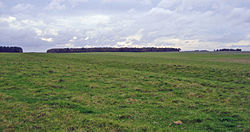

Cursuses are monumental Neolithic structures resembling ditches or trenches in the islands of Great Britain and Ireland.[1] Relics found within them indicate that they were built between 3400 and 3000 BC, making them among the oldest monumental structures on the islands. The name 'cursus' was suggested in 1723 by William Stukeley, the antiquarian, who compared the Stonehenge cursus to a Roman chariot-racing track, or circus.[2]
Cursuses range in length from 50 yards (46 m) to almost 6 miles (9.7 km). The distance between the parallel earthworks can be up to 100 yards (91 m). Banks at the terminal ends enclose the cursus. Over fifty have been identified via aerial photography while many others have doubtless been obliterated by farming and other activities.[3]
The Stonehenge Cursus is a notable example within sight of the more famous Stonehenge stone circle. Other examples are the four cursuses at Rudston in Yorkshire, that at Fornham All Saints in Suffolk, the Cleaven Dyke in Perthshire and the Dorset cursus.[4] The Bures cursus and the Metlands cursus are in Bures St Mary, Suffolk, and were detected from cropmarks. They are situated just above the floodplain of the north bank of the River Stour, Suffolk.[5] On 21 December each year the sun rises over Lodge Hills, Wormingford, and shines down the length of the Metlands cursus.
In the summer of 2023 excavation began at a cursus discovered near Drumadoon in the Isle of Arran in 2019. It is believed to be the only complete example in Britain. Archaeologists from Glasgow University co-led by Dr Kenneth Brophy and local volunteers began excavating at the site in August. Brophy judged the Arran cursus the most significant he had seen in his career.[6]
- ^ McOmish, 1999
- ^ The Stour Valley: a Prehistoric Landscape, Colchester Archaeological Group
- ^ Peter James and Nick Thorpe (November 1999) "Ancient Mysteries", p,316-9.
- ^ Champion, 2005
- ^ The Stour Valley: a Prehistoric Landscape, Colchester Archaeological Group
- ^ Vast Neolithic monument found on Isle of Arran